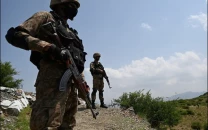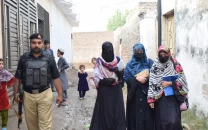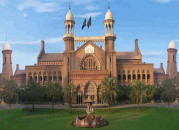Swept away: Waiting for the inevitable
The annual flooding commences in G-B, taking down houses and wrecking lives.

Villagers looking on helplessly as erosion continues. PHOTO: SHABBIR MIR / EXPRESS
In the past three weeks, at least three of his relatives have already lost their dwellings, built on the eroding land in Hoto village, around 15 kilometres from Skardu, in Gilgit-Baltistan. Clearly, although unknown to many Pakistanis, the treacherous flooding of the year is already well under way.
Lives irrevocably altered
“We know our house is the next to go,” says Ali, who now lives with his mother, wife and three children in a tent across the road. “We are just waiting for it to happen.”
Ali’s village, Hoto, is situated at a height of nearly 20 metres from the Skardu river and runs alongside a main road. In summers, as the glacier melting process intensities, flooding rivers and tributaries across Gilgit-Baltistan (G-B), the loose structure of the soil is too weak to sustain the water onslaught.
And yet, Ali isn’t interested in scientific debates over melting glaciers and the speed of corresponding changes in climate. All he and other villagers know is that something strange is happening, something that is altering their lives irreversibly.
As the soil erosion has escalated, so have the desperate efforts of the villagers to salvage what they can. Ali’s relatives have taken everything they could carry – even doors and windows – to different locations.

“Since early May, more than 3,000 canals of land have been washed away by the angry river,” Ali remarks, pointing to a curve where once, not too long ago, stood proud houses. The area has now been cordoned off by the police. Helpful police personnel have also helped villagers relocate their belongings to secure, but makeshift, locations.
“I am upset, my mother is upset,” says Ali, waving his arm around the tent to draw attention to their bare living arrangements. “We want to be rehabilitated permanently somewhere else.”
G-B wails under water
Unfortunately, Hoto is not the only area affected. This month, flashfloods swept away 12 houses in Ghizer valley and partially damaged 50 others in Dalnati village. Furthermore, nearly one kilometre of the road linking G-B with Shandur was submerged as the river flooded and changed its direction at the Sosat area of Ghizer. As a result, more than 20,000 people in the upstream valleys, including Phandur, found themselves stuck.
Looking to the future
The Himalayas - the world’s biggest and highest mountain range, stretching from Afghanistan and Pakistan in the west to the Yunnan in southwest China in the east – are often referred to as the “third pole”, containing more water and ice than any other area on the planet, aside from the arctic and Antarctica.
“There is a change in the pattern of river flow,” explains Shehzad Shigri, an official in the Environmental Protection Agency. “The increase in river flow isn’t gradual. It’s sudden, with more velocity.”
According to Shigri, in the long term, such disasters may be countered by planting more trees. “However, immediately, erosion can be slowed down by placing boulders in places that are exposed to soil erosion,” he says.
Adapting to ever greater fluctuations in climate is a serious challenge for residents of G-B.
As part of rehabilitation plan, the G-B government has allocated funds to deal with the natural disasters across the region, particularly in those areas that cope with an increasingly uncertain future.
“As a quick response, we have approved Rs50,000,000 to deal with the issue in this region,” says Law Minister Ali Madad Sher. “Hoto is also included in this.”
Published in The Express Tribune, June 27th, 2013.



















COMMENTS
Comments are moderated and generally will be posted if they are on-topic and not abusive.
For more information, please see our Comments FAQ